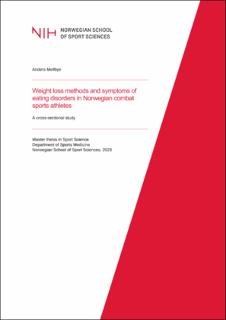| dc.description.abstract | Purpose: To explore weight loss methods, eating disorder (ED) symptoms, explanatory factors, and differences in ED symptoms across gender, experience levels, and disciplines among a diverse sample of adult Norwegian combat sports athletes.
Methods: Self-reported data from a larger cross-sectional study was utilized. Participants responded to an electronic questionnaire on health, competition, eating, and sport-specific behaviors. The Eating Disorder Examination - Questionnaire (EDE-Q) was included to assess ED symptoms among the participants.
Results: The final data material consisted of 187 participants. In total, 88% of the participants had practiced some form of weight regulation in the last 12 months. Restricting energy intake, increasing exercise levels, and restricting carbohydrate intake were the most common weight loss methods practiced by both male and female combat sports athletes. Of the combat sports athletes viable for analysis (166), 46% displayed symptoms of EDs, whereas 49% and 40% were observed among the male and female groups, respectively. Significant differences in ED symptoms were found across gender and experience level, whereas no significant differences were observed across combat sports disciplines. Combat sports exercise volume and body mass index (BMI) were significant explanatory factors for ED symptoms among the athletes.
Conclusion: The study sheds light on the prevalence of weight regulation practice among Norwegian combat sports athletes, highlighting the predominance of what can be regarded as safe weight loss methods. However, a considerable proportion of the athletes displayed symptoms of ED, whereas a higher proportion was found among the male athletes compared to the female athletes. As such, these results warrant a need for action regarding early identification of disordered eating behavior, as this may safeguard combat sports athletes mental and physical health. The findings provide further insight of potential groups which may be at an increased risk of ED symptoms and identifies possible explanatory factors for these behaviors. | en_US |
